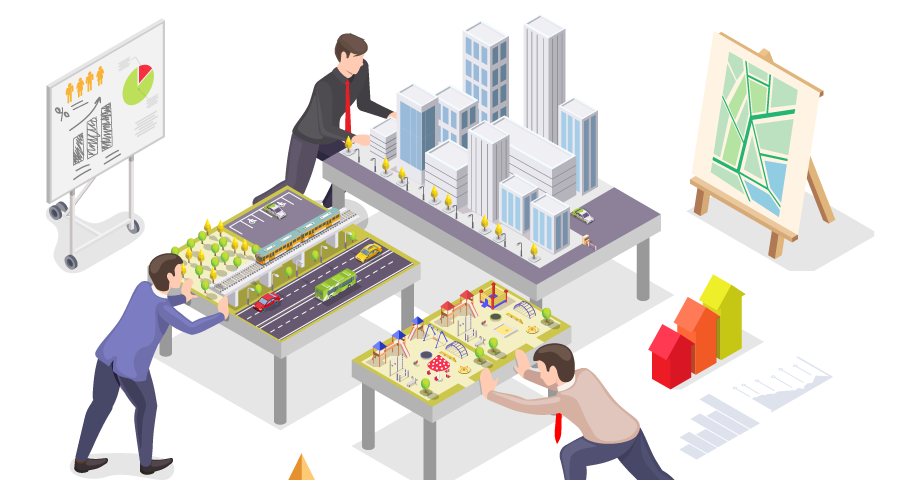Live-Work-Play communities are a type of mixed-use development based on the idea that residents don’t need to leave a given area to access all of their living needs, including residential housing, office complexes, shopping, recreation, restaurants, or other amenities. The concept aims to help prime markets produce more high-density, affordable housing amid shortages while creating desirable and sustainable urban development. These communities are on the rise in the post-pandemic era, as workplace flexibility remains a priority for employees.
Rental communities qualify as live-work-play communities by combining office, residential, or employee uses over the last 10 years, increasing from 10,000 to 43,000 apartment units per year. Since the concept provides an innovative solution for the lack of space, live-work-play communities are most common in high-density urban areas. Currently, New York, Washington D.C., Chicago, and Los Angeles are the U.S. cities with the largest number of apartments in live-work-play buildings. In the future, you can expect to see more opportunities for live-work-play development projects in dynamic urban areas as a way to meet community needs and address housing shortages.
Here’s everything you need to know about the live-work-play community concept, including the benefits and challenges of incorporating these communities into your portfolio:
Understanding Live-Work-Play Community Concepts
In order to take advantage of growing opportunities in the live-work-play space, you’ll need to fully understand the development concept and how it seamlessly blends residential, office, and lifestyle amenities.. Let’s further break down the key components of these large-scale mixed-use developments:
Live
The residential component of a live-work-play community is essential for the project’s success and can include apartments, condos, townhouses, and more. The best strategy is to include a variety of different housing types to suit residents at various income levels and different lifestyles, helping to better ensure demand for your community. Most live-work-play communities are in high-density urban centers and offer living options suitable to meet housing needs.
Work
Your live-work-play development should incorporate employment opportunities within the community itself or in close proximity to the community. Following the pandemic, workplace flexibility became a priority for many workers, and live-work-play communities can offer a wide range of employment opportunities. Employment opportunities can be found at office spaces, coworking facilities, retail shops, or industrial spaces. Job opportunities in a live-work-play community can help boost local economies, which in turn results in greater buy-in from government officials or other stakeholders.
Play
The play component is the component that varies the most between individual live work play communities variable component and can include recreational, retail, or open green space. Your offerings in terms of play should cater to community needs or be curated for your target tenant. You should conduct thorough research to ensure the amenities offered as part of your project are suitable for the area and demographics of your target market. By conducting market research to better understand the social needs of the community, you can help further increase demand. For example, if the surrounding area doesn’t have a strong variety of fitness facilities, gyms or recreational green spaces can be a positive addition to your community.
Key Components of Successful Live-Work-Play Communities
Successful live-work-play communities have several elements that help drive demand and contribute to their success. Here are a few considerations you can make to better position your project and ensure high returns:
Meets Resident’s Needs
The most successful live-work-play communities provide convenient access to basic needs, such as convenient access to groceries or medical care. Evaluating the needs of residents and offerings in the immediate community can help you ensure sustained profitability for your residential offerings. While many live-work-play developments are located in cities with existing infrastructure to meet residents’ needs, you should look for any gaps and determine if your project can help meet community needs. As an example, many mixed-use developments include grocery outlets or urgent care medical clinics designed to serve both residents and the greater community.
Residential Offerings Across Age + Cost Points
The most ideal live-work-play communities will offer housing suitable for all ages and stages of life, with units offered in different sizes, styles, and at various price points. Rental space in live-work-play developments can include apartments, condominiums, townhouses, studio space for artists or entrepreneurs, and single-family homes. By including a variety of flexible spaces such as studios, offices, or event halls to rent in your development, the project will be better positioned to generate high demand and be more resilient to economic shocks.
Walkability + Community Oriented
Urban areas are increasingly viewing mixed-use developments as essential to shaping sustainable and walkable communities. Building your live-work-play community in close proximity to transit and ensuring access to green space can help increase demand. By contributing to community-oriented initiatives, you will also be contributing positively to how cities are shaped and helping bolster your firm’s reputation with stakeholders.
Benefits of Live-Work-Play Assets for Developers
Live-work-play projects can provide several key benefits to developers and local communities, such as offering residential options to communities experiencing housing shortages and lowering risk by combining asset classes. Mixed-use developments that offer office, retail, and residential space are more economically resilient. If one asset class goes into decline, the others will continue to generate income and bolster the longevity of the property.
Sustainability is also a major benefit for developers. Renters are increasingly looking for live-work-play communities that are environmentally conscious. A recent study found that 61% of renters are willing to pay more for an eco-friendly property. In addition, a majority of people – around 60% – favor neighborhoods with a walkable mix of housing and retail instead of driving between home, work, and play. Live-work-play communities are aligned with these demographic trends, which can help you further ensure high returns.
Live-Work-Play communities are also often eligible for tax credits or other government incentives designed to kickstart housing production and further help you bring down costs. Developments meeting affordable housing requirements will be eligible for low-income housing tax credits (LIHTC) and projects in close proximity to public transportation can also receive transit-oriented community incentives. Government funding sources and benefits can help your team get complex live-work-play projects off the ground even amid stalled capital deployment and uncertain market conditions.
Challenges in Live-Work Play Development
Even though live-work-play assets have many benefits for developers, the assets are not without unique challenges. Land acquisition and zoning restrictions will be among the biggest challenges your development team will face in the development process. Finding the appropriate land and securing zoning approval for all uses on the property can be a long and intensive process. However, in recent years, state and local governments have been shifting zoning laws and regulations to boost housing production. Zoning for high-density housing in the area of public transportation,
Other challenges you may face over the development process include securing stakeholder approval from local governments and planning boards. Developers will need to conduct thorough market research and due diligence to ensure the property meets residents, businesses, and the surrounding community’s needs. Your property should be a well-designed, sustainable environment that promotes social interaction, and economic profitability, and boosts quality of life. Demonstrating how the property will contribute positively to the community can better facilitate buy-in from relevant stakeholders.
Leveraging technology can help you overcome many of these challenges and ensure your complex development projects, including live-work-play communities, are successful. Modern real estate development software can help you keep a project on track and on budget as early as pre-development. Tools like Northspyre accurately track every aspect of your project’s finances including contingency, variance, available funds, cost per square foot, acquisition costs, and more. The platform’s anticipated cost report also acts as a risk detection tool, flagging potential overruns and letting you address concerns before things get out of hand. AI-powered features can also help your team lower bidding costs, eliminate scope gaps, and remove the guesswork from vendor selection so you can maximize your profits.
Learn More About Northspyre
Northspyre is a purpose-built, single software solution designed using automation to reduce manual data entry, increase productivity, and maximize your returns from pre-development to project completion. The cloud-based platform enables you and your team to ensure every aspect of your project is at your fingertips for simple and effective project management. Northspyre is designed by and for developers and helps teams all reduce administrative tasks by up to 80% and reduce budget overruns by 66%.
Download our white paper “It’s Time to Address Tech Debt in Commercial Real Estate” to learn how you can reimagine the role technology plays in your real estate firm, saving time and increasing returns.”



